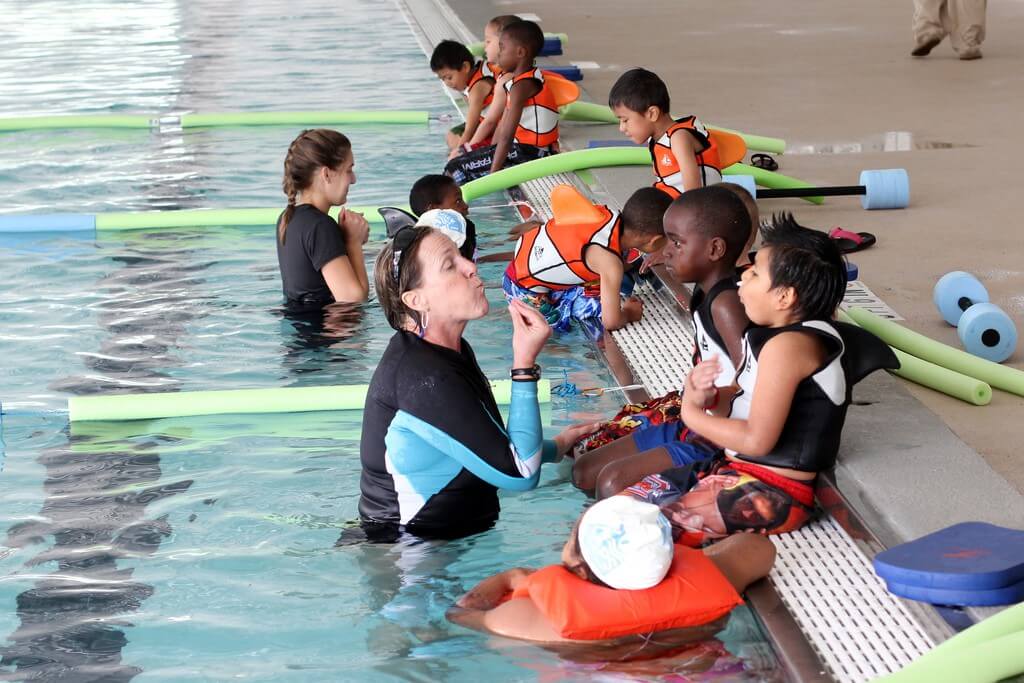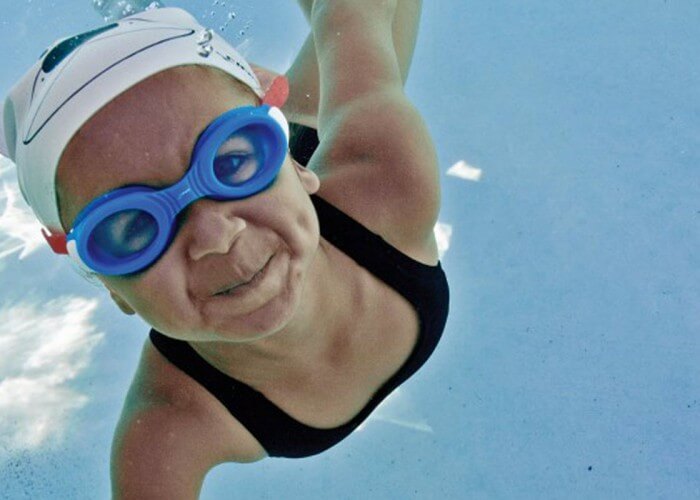4 Swim Lesson Flaws that Haunt Today’s Swimmers

By Tori Caudill, Swimming World College Intern
Taking swimming lessons is common at a young age. Ages three and up will crowd pool facilities for half-hour lessons to learn the fundamentals of the sport. Fun gimmicks and mnemonic devices are sometimes the best way to teach these fundamental skills of swimming to the lively youths.
However, with the constantly evolving stroke techniques, some of these ghosts of swim lessons past may come back to bite the swimmers hoping to transition into the more elite levels of competition.
Here are four parts of swim lesson curriculum some of us wish we could forget…
1. Picking apples to develop freestyle.
One popular way to teach the freestyle arms to young swimmers is with the concept of grabbing apples from a tree and placing them into a basket to re-submerge the arm in the water. This increases the tendency of the swimmer to develop a straight arm freestyle, with an inefficient underwater pull. Another possible effect of using the picking apples technique is the development of a freestyle stoke that is cut short, which again results in stroke inefficiency. But these possible negative outcomes of the understandable analogy does not mean that picking apples should remain exclusively in an orchard. As long as the habits are corrected by the instructor, picking apples is still a fun way to teach freestyle.
2. Knees-down butterfly kick.
For some reason, when first learning butterfly kick, kids have a tendency to only kick from the knee down instead of engaging the whole body. This comes from the teaching of dolphin kick without highlighting the chest press and hip movements that accompany the butterfly kick. One possible way to correct this kick is to train the swim lesson children with fins, if available, in order to allow for a more controlled kick. Another way to resolve the knees-down butterfly kick would be to incorporate the teaching of the chest press and hip movement along with the kick, to train the new swimmers to take advantage of the full body involvement that creates a more efficient foundation for butterfly kick, and the stroke itself.
3. Making and cutting pie.
Breaststroke seems to the most complex stroke for a swim student to learn. When focusing on the arm movement, one technique that can be used is the pie concept. This concept involves making a circle with your arms (making the pie), and then forming a slice with your arms and thrusting them forward (cutting the pie.) This way of teaching breaststroke paves the way for two technique problems. The first issue that could lead to is a tendency to drop the elbows and bring the hands all the way to the chest making it very hard to get an effective pull out of the stroke. Another issue this could lead to is an ineffective reach because of a tendency to overshoot the water, losing the power from the stroke. This technique can be modified by “making the pie” smaller in front of the body correcting the first issue, and emphasizing a skating water extension.
4. Bigger frog kick is better.
Breaststroke kick has been evolving for years. Part of this evolution has included the decrease in size of the kick. In swim lessons, many times breaststroke kick has been taught as frog kick, because of the likeness of early breaststroke kick to that of a frog. This wide, simplistic view has become extremely outdated. When teaching breaststroke, a way to correct this kick would be to introduce the idea of keeping the knees together (perhaps with a buoy), while turning the feet out, allowing the swimmer to correct the previously learned kick.
Swimming technique has changed dramatically just over the past decade. With these changes, swim lesson instructors (who usually have a background in swimming themselves) should also be looking for new ways to impart these technical changes to their students.






Zoe McIlmurray
In 28 years of teaching lessons I’ve not taught freestyle arms with “pick an apple and put it in the bucket”. This article is ridiculous.
No, it isn’t. This crap does persist.
I agree with the breaststroke flaws. However the apple picker in my lessons has only ever been used to teach side stroke which is a life saving stroke (now removed from lifeguard classes ).
I agree with you. We still use the “apple picker” for side stroke where I teach, but for freestyle arms, we have been teaching the students to make “spoons” with their hands and “scoop the ice cream” toward them.
I commonly see these type of teaching mistakes at our gym. It relies a lot on the competitive swimmer as a teacher vs a novice swimmer teaching.
It doesn’t mention the I’ll taught timing of breast stroke…that’s a pain to correct.
I once spent a whole half hour class on that… they wouldn’t get it
Never heard of picking apples
I think pick an apple was for sidestroke. Is sidestroke still a thing?
Jennifer Metituk
I’ve found the big tummy/little tummy approach to be quite helpful for teaching dolphin kicks. However, some kids don’t learn certain skills as easily and even though you tell them how to do a move, some of these listed “swim lesson flaws” are how their body interprets a movement.
Wow If we are not trying to create new word pictures descriptions and metaphors to create the most effective stroke for each swimmer…what are we doing?
I have never had a swimmer who has described an effective freestyle “like picking apples!” I don’t think it feels like picking apples but I was never the best either!
Our swimmers watch top swimmers and their peers with balanced body position and feel for the water on the poolside TV, they develop the concept of feel through sculling games and activities. They learn to feel for the best use of their shoulders following scapular plane awareness activities and they understand where they are in the water and how to maintain balance at the surface with balance awareness games (push /pull, stationary turns, ball to line etc) Learning to swim is about making effective shapes with your body that are easily and effectively moved through the water within the guidelines of the swimming rules. There is no one movement pattern or action that suits all swimmers. everyone holds tension in different places and to different extents under different circumstances, we need to be able to identify this and help each swimmer to “let go” to be the most effective they can be with their body.
I no longer teach group lessons, but teach discovery in the water; attention goes to what are the issues and goals that they should be trying to achieve. I let them learn to swim by discovering about their body and how forces in the water affect their movement in their journey through the water. I provide tips on how to become aware of what is happening and the why. I don’t teach children under 10, so I can’t relate to this article except that it might explain why I must explain why their movements aren’t in line with how we swim today. It seems this article is about some totally unqualified water safety instructors copying other unqualified instructors, sort after the motto: God forgive them for they know not what they are doing. But I’m sure they are having fun doing it.
Whilst I might use bits of these and none of others, the point being that initially we are teaching swimming to three year olds, if the lessons are fun and the children get the basics (perfect or not) as they grow older, more confident they also begin to understand that their technique needs to improve. It’s very rare to get a 3/4 year old to understand, they just want to have fun and move through the water in any way they can!
Hi Tori: I had been teaching swim lessons since 1992, I personally never use the picking apple analogy but the reason it can be used is that depending on the age, development and abilities we might use “word-pictures” to describe movements. Again this is related to age/mental development and, with swimmers ageing and progress an instructor or coach should change the methodology accordingly. I don’t think the “word-pictures” should be a problem as long as it is corrected or addressed.
I think if it helps the young kids to do something however it is ”pictured’ then that’s fine, young kids are there to learn in a fun way!! There is plenty of time for them to do strokes 100% correct, if they need to!! Not everyone is going to be a fantastic swimmer, surely water safety and water confidence first not getting a young child to perform a stroke to perfection!!! Some of the ones I teach are great swimmers at 3/4 yrs old but most are not and just want to play so we learn thru play! Let them be…they have their whole life to learn!